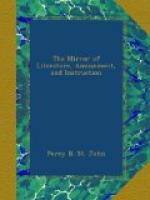“Behold renown’d Scotus take
his stand
Beneath a tree’s deep shadow, and
there draw
His magic circle—in its orb
describe
Signs, cycles, characters of uncouth shapes;
And with imperious voice his demons call.
Four devils come—one from the
golden west,
Another from the east; another still
Sails onwards from the south—and
last of all
Arrives the northern devil; by their aid
He forms a wondrous bridle, which he fits
Upon a jet black steed, whose back, nor
clothes,
Nor saddle, e’er encumber’d—Up
he mounts,
Cleaves the thin air like shaft from Turkish
bow,
Eyes with contemptuous gaze the fading
earth,
And caprioles amongst the painted clouds.
Oft, too, with rites unhallow’d,
from the neck
Of his dark courser he will pluck the
locks,
And burn them as a sacrifice to Him
Who gives him power o’er Nature:
next he limns
With silver wand upon the smooth firm
beach
A mimic ship—look out, where
ocean’s verge
Meets the blue sky, a whitening speck
is seen,
That nears and nears—her canvass
spreads to heav’n;
Fair blows the wind, and roaring through
the waves,
On comes the Demon ship, in which he sails
To farthest Ind—but this adventure
needs
A sacrifice more potent—human
marrow
Scoop’d from the spine, and burnt
to the dark power
Whom he must serve. ’Tis said
that he who wears
His magic cap, invisible may walk,
And none so lynx-eyed as detect his presence,
In the most peopled city—yet
beware,
Let him not, trusting to the demon’s
power,
Cross the white splendour of the sun,
for there,
Although no palpable substance is discern’d,
His shadow will betray him.”
Such is a somewhat free translation of the verses of the pretended Merlinus Coccaius.[8] It is well known that many traditions are still prevalent in Scotland concerning the extraordinary powers of the Wizard; and if we consider the thick cloud of ignorance which overspread the country at the period of his return from the continent, and the very small materials which are required by superstition as a groundwork for her dark and mysterious stories, we shall not wonder at the result. The Arabic books which he brought along with him, the apparatus of his laboratory, his mathematical and astronomical instruments, the Oriental costume generally worn by the astrologers of the times, and the appearance of the white-haired and venerable sage, as he sat on the roof of his tower of Balwearie, observing the face of the heavens, and conversing with the stars, were all amply sufficient to impress the minds of the vulgar with awe and terror. “Accordingly,” says Sir Walter Scott, in his Notes on the Lay of the Last Minstrel, “the memory of Sir Michael Scott survives in many a legend, and in the south of Scotland any work of great labour and antiquity is ascribed either to the agency of Auld Michael, of Sir William Wallace, or of the devil.”




